





|
|
|
|
March 19, 2006
Buried treasure can be a gas
While shopping at the supermarket, yesterday, I forgot my common sense instincts and committed a spontaneous act of frivolity. (And now I'm now wondering about the moral dynamics, if any.) When I opened the trunk of my used car (it was "pre-owned" by persons unknown to me), I noticed a round piece of plastic wedged way down between the wall of the fender and the floor of the trunk. It turned out to be really wedged in, but when I pried it out, I discovered that it was a container holding a roll of 35mm camera film. This was odd, because I haven't used regular cameras in years, and I've only owned the car since 2004, so I knew it wasn't mine. I had no use for it, but when I pulled out the roll I saw that the film had been rolled inside -- which meant it was probably someone else's exposed film. Mystery film! And there I was -- just yards away from the supermarket which has a film dropoff bin. Without bothering to think things through, I ran in, filled out the envelope, checked the box for the cheapest development option, and left the film there. Assuming the developed film reveals photographic images, and I pick them up, does that mean that I would be snooping into the lives of total strangers I never met, and whose names I don't know? (I bought the car from a dealer.) Worse still, what if the film contains illegal images? Would the FBI have the right to arrest me for having possessed it and having it developed? The legal issues are perplexing indeed, which is why I'm writing this blog post. (As the bureaucrats say, "CYA" . . .) Normally, I would never take such leave of my senses and do something so irresponsible as developing "found photos." Should I blame Glenn Reynolds? (His post may very well be what originally planted the "undeveloped" idea in my impressionable mind.) Is there any responsibility on the part of the finder for items he may have found? I mean, if I find it, is it mine? Or do I have to possess it in a "willful" manner? (Finders weepers, perhaps?) And speaking of "found" items, look what Coco has been trying to drag into my house. 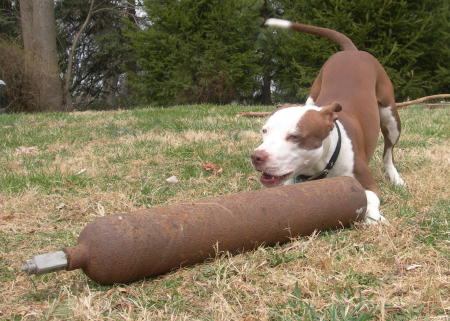 That rusted old cylinder has been half buried in the yard for years (long before I lived here), and I was getting ready to have it hauled away as junk. But Coco, obviously, can't leave well enough alone. 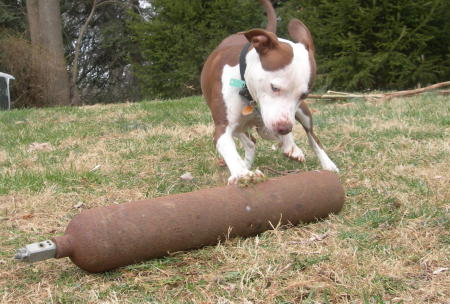 As a matter of fact, Coco has become obsessed with the thing, because she can't lift it or tear pieces off of it as she would with a log. All she can do is roll it around, and it's tough to show the movement in still pictures, but I think you can see that she's doing her best to grip the tank with her paws. But biting the tank didn't work. Nor did she find straddling and gripping especially fruitful: 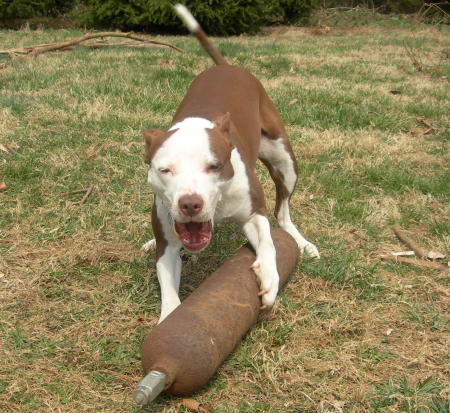 The tank valve is the only thing small enough for Coco to bite: 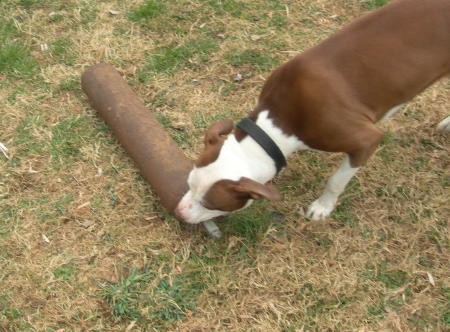 But that was also unproductive. So she just rolled it around the yard like a steamroller. Eventually, she became so annoyed with the thing and was making so much noise barking and growling at it that I had to drag her back in the house. Might Coco have been trying to tell me that this tank was a very evil thing? I know a little bit about cylinders because I'm a SCUBA diver, and I know a little bit about medical gases from hanging out in hospitals, so I know that tanks can often be identified by their valves. That's because the valves are designed to avoid potentially lethal human errors like hooking up the wrong tank to the wrong intake hose. Tanks used in hospitals come in similar sizes (the one in my yard is an "E" size), but as explained here "the valves are specific for each gas." In technical parlance, the valves are differentiated by something called a "pin index yoke system": A gas-specific pin-index system is provided on small cylinders: pins on the yoke of the anaesthetic machine mate with holes drilled in specific positions on the valve of the cylinder to provide a mechanical means of preventing incorrect connection.Here's the illustration from the above site: 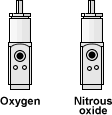 So, while oxygen tanks are green and nitrous oxide tanks are blue, even a color blind, mentally challenged hospital worker would be physically incapable of hooking up a nitrous tank to an oxygen line or vice versa. Coco's tank (well, it isn't mine, and she's more interested in it than I am, so I'll call it hers) is so thoroughly rusted that there's no way to identify it by color. But here's a closeup of the valve, showing the pin yoke part: 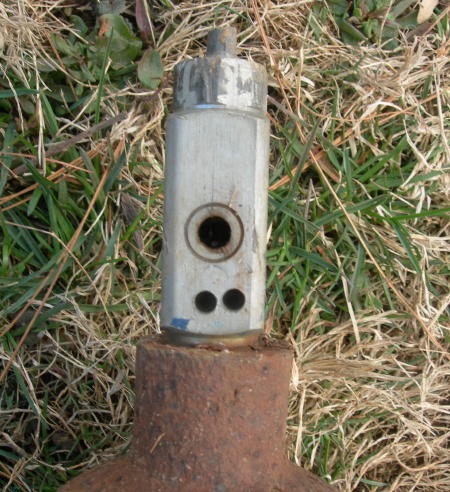 Uh-oh! I'd say those off-center yoke pins are a dead giveaway as to the nature of the tank. Of course, Coco's a rather humorless sort, and she takes these things much too seriously. I hope she forgives me for saying this in my blog, but Coco just doesn't understand yokes. Even nitrous oxide yokes. Nitrous oxide, folks. That's laughing gas. No laughing matter! posted by Eric on 03.19.06 at 11:47 AM
Comments
Well, then I did the right thing by dragging her away from it. (Addicts need tough love, you know....) Eric Scheie · March 20, 2006 11:13 PM |
|
March 2007
WORLD-WIDE CALENDAR
Search the Site
E-mail
Classics To Go
Archives
March 2007
February 2007 January 2007 December 2006 November 2006 October 2006 September 2006 August 2006 July 2006 June 2006 May 2006 April 2006 March 2006 February 2006 January 2006 December 2005 November 2005 October 2005 September 2005 August 2005 July 2005 June 2005 May 2005 April 2005 March 2005 February 2005 January 2005 December 2004 November 2004 October 2004 September 2004 August 2004 July 2004 June 2004 May 2004 April 2004 March 2004 February 2004 January 2004 December 2003 November 2003 October 2003 September 2003 August 2003 July 2003 June 2003 May 2003 May 2002 See more archives here Old (Blogspot) archives
Recent Entries
• War For Profit
• How trying to prevent genocide becomes genocide • I Have Not Yet Begun To Fight • Wind Boom • Isaiah Washington, victim • Hippie Shirts • A cunning exercise in liberation linguistics? • Sometimes unprincipled demagogues are better than principled activists • PETA agrees -- with me! • The high pitched squeal of small carbon footprints
Links
Site Credits
|
|
Maybe Coco does understand what it is and she's trying to bring it inside so you'll turn it on. I mean that's addict-worthy behavior.